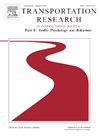基于轮椅型个人机动车辆避碰角色的凝视功能差异
IF 3.5
2区 工程技术
Q1 PSYCHOLOGY, APPLIED
Transportation Research Part F-Traffic Psychology and Behaviour
Pub Date : 2025-04-01
DOI:10.1016/j.trf.2025.03.016
引用次数: 0
摘要
近年来,个人机动车辆(pmv)的发展扩大了行人和不同形式的机动互动的共享空间。在这些共享空间中,交通参与者必须使用不同于与行人互动时使用的策略与pmv互动。本研究的目的是阐明注视对象在避碰过程中的角色差异。该实验测量了两辆轮椅式pmv在彼此擦肩而过并避免碰撞时的凝视、位置信息和对伴侣意图的理解。结果表明,注视在避碰中的作用不同,其功能也不同。首先,我们观察到,首先通过碰撞点的领导者注视同伴,要求协调行为;随后通过碰撞点的追随者注视同伴,提示协调行为,调整自己的行为。其次,我们的研究结果表明,只有追随者的注视才能提高理解和传达同伴意图的评分。这些发现提供了证据,证明凝视是两个pmv之间避免碰撞的关键信息来源,其利用取决于角色。本文章由计算机程序翻译,如有差异,请以英文原文为准。
Functional differences in gaze based on roles in collision avoidance between wheelchair-type personal mobility vehicles
Recently, the development of personal mobility vehicles (PMVs) has expanded shared spaces where pedestrians and different forms of mobility interact. In these shared spaces, traffic participants must interact with PMVs using strategies different from those used when interacting with pedestrians. This study aimed to elucidate the role-based differences in the function of gaze toward the partner in collision avoidance between PMVs. The experiment measured gaze, positional information, and understanding of the partner's intentions as two wheelchair-type PMVs passed each other and avoided collision. The results showed that the function of gaze varies based on roles in collision avoidance. First, we observed that the leader, who passes through the collision point first, gazes toward their partner to demand coordination behavior, while the follower, who passes through the collision point later, gazes at their partner to prompt coordination behavior and adjust their own behavior. Second, our results showed that only the follower's gaze improves the ratings of understanding and conveying the partner's intentions. These findings provide evidence that gaze is a critical source of information in collision avoidance between two PMVs, and its utilization varies depending on the role.
求助全文
通过发布文献求助,成功后即可免费获取论文全文。
去求助
来源期刊
CiteScore
7.60
自引率
14.60%
发文量
239
审稿时长
71 days
期刊介绍:
Transportation Research Part F: Traffic Psychology and Behaviour focuses on the behavioural and psychological aspects of traffic and transport. The aim of the journal is to enhance theory development, improve the quality of empirical studies and to stimulate the application of research findings in practice. TRF provides a focus and a means of communication for the considerable amount of research activities that are now being carried out in this field. The journal provides a forum for transportation researchers, psychologists, ergonomists, engineers and policy-makers with an interest in traffic and transport psychology.

 求助内容:
求助内容: 应助结果提醒方式:
应助结果提醒方式:


